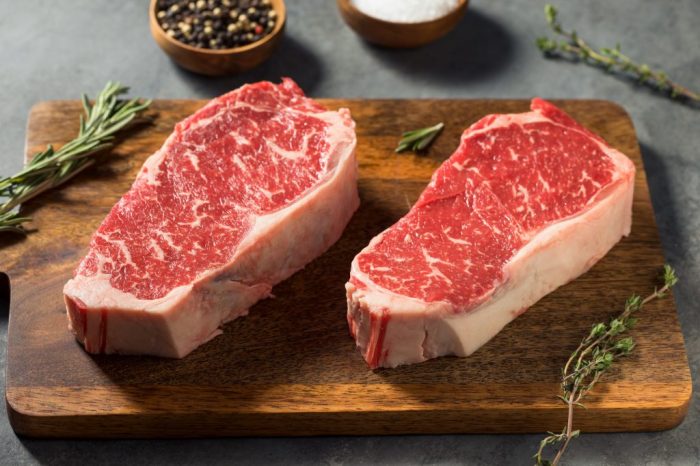Nutritional Composition of New York Strip Steak

Nutrition facts new york strip steak – New York strip steak, known for its rich flavor and tender texture, is a popular choice among beef enthusiasts. Understanding its nutritional profile is crucial for making informed dietary choices. This section details the macronutrient and micronutrient composition of a typical serving, and compares it to other popular beef cuts.
Macronutrient Breakdown of a 3-ounce Serving
A 3-ounce serving of New York strip steak typically contains approximately 190-220 calories. The macronutrient distribution varies slightly depending on the level of marbling, but a general breakdown is as follows: Protein comprises a significant portion, usually around 25-30 grams, contributing to muscle growth and repair. Fat content ranges from 10-15 grams, providing essential fatty acids and contributing to the steak’s flavor and tenderness.
Understanding the nutrition facts of a New York strip steak is crucial for balanced eating. A key aspect to consider alongside the steak’s nutritional profile is your beverage choice; for example, you might want to check the nutrition facts for 8 oz coffee if you’re pairing it with a morning meal. Returning to the steak, remember to factor in portion size to manage your overall calorie and nutrient intake.
Carbohydrates are negligible, typically less than 1 gram per serving. These values represent approximate percentages of daily values, which vary based on individual caloric needs. For example, the protein content could represent 20-25% of a 2000 calorie diet’s recommended protein intake. The high protein content makes it a valuable component of a balanced diet for those seeking to build or maintain muscle mass.
The fat content should be considered within the context of overall daily fat intake.
Micronutrient Content and Health Benefits
Beyond macronutrients, New York strip steak offers a variety of essential micronutrients. It is a good source of iron, crucial for oxygen transport in the blood and preventing anemia. Zinc, another important mineral found in strip steak, plays a vital role in immune function and wound healing. Selenium, an antioxidant mineral, protects cells from damage caused by free radicals.
The steak also contains B vitamins, such as niacin and vitamin B12, which are essential for energy metabolism and nerve function. Vitamin B12, in particular, is important for red blood cell formation and neurological health. Vitamin E, another antioxidant, helps protect against cell damage. The specific amounts of these micronutrients vary slightly depending on factors like the animal’s diet and rearing conditions.
Comparison to Other Beef Cuts
The nutritional profile of New York strip steak differs somewhat from other popular beef cuts. The following table provides a comparison of protein, fat, and calorie content in a 3-ounce serving of various cuts. Note that these are approximate values and can vary based on factors like marbling and preparation methods.
| Cut of Beef | Protein (g) | Fat (g) | Calories |
|---|---|---|---|
| New York Strip | 26 | 12 | 210 |
| Ribeye | 24 | 16 | 240 |
| Filet Mignon | 27 | 8 | 180 |
New York Strip Steak in a Balanced Diet

Incorporating New York strip steak into a balanced diet requires mindful consideration of its nutritional profile, particularly its higher fat content. Successfully integrating it means balancing its rich protein and iron with ample servings of fruits, vegetables, and whole grains to create a nutritionally complete and satisfying eating pattern. The key is moderation and thoughtful meal planning.
To maintain a healthy intake of fats, proteins, and carbohydrates while enjoying New York strip steak, it’s crucial to understand its place within the broader context of your daily caloric needs. The steak should complement, not dominate, your meal. Prioritizing lean protein sources on other days and balancing the steak’s fat content with nutrient-dense choices is essential for overall health.
Meal Examples Incorporating New York Strip Steak, Nutrition facts new york strip steak
The following examples demonstrate how to create balanced meals featuring New York strip steak, ensuring a varied intake of nutrients. Each meal includes a lean protein source (the steak), healthy fats, complex carbohydrates, and plenty of vitamins and minerals from vegetables.
- Grilled New York Strip Steak with Roasted Asparagus and Quinoa: A 4-ounce New York strip steak, grilled to medium-rare, served alongside a generous portion of roasted asparagus and a side of fluffy quinoa. This meal provides a good balance of protein, healthy fats from the steak, fiber from the asparagus and quinoa, and essential vitamins and minerals.
- New York Strip Steak Salad with Mixed Greens and Sweet Potato: A 3-ounce serving of New York strip steak sliced thinly and added to a bed of mixed greens, topped with a baked sweet potato, and dressed with a light vinaigrette. This option offers a lighter meal with a good source of protein, fiber, and vitamins.
- New York Strip Steak with Sauteed Spinach and Brown Rice: A 4-ounce New York strip steak pan-seared with a small amount of olive oil, served with a side of sauteed spinach and a cup of brown rice. This provides a balanced meal with a focus on iron-rich vegetables and complex carbohydrates.
Sample Weekly Meal Plan
This sample weekly meal plan incorporates New York strip steak one to two times a week, while emphasizing variety and overall dietary balance. Remember to adjust portion sizes based on your individual caloric needs and activity level.
| Day | Breakfast | Lunch | Dinner |
|---|---|---|---|
| Monday | Oatmeal with berries and nuts | Chicken salad sandwich on whole-wheat bread with a side salad | Salmon with roasted broccoli and sweet potato |
| Tuesday | Greek yogurt with granola and fruit | Leftover salmon and vegetables | New York strip steak with sauteed spinach and brown rice |
| Wednesday | Scrambled eggs with whole-wheat toast and avocado | Lentil soup with a side salad | Chicken stir-fry with brown rice |
| Thursday | Smoothie with fruits, vegetables, and protein powder | Tuna salad on whole-wheat crackers with vegetables | New York strip steak with roasted asparagus and quinoa |
| Friday | Breakfast burrito with eggs, black beans, and salsa | Leftover chicken stir-fry | Vegetarian chili with cornbread |
| Saturday | Pancakes with fruit and syrup (in moderation) | Sandwich with lean turkey and whole-wheat bread | Pizza with whole-wheat crust and plenty of vegetables |
| Sunday | Omelet with vegetables and cheese | Leftover pizza | Roast chicken with roasted potatoes and green beans |
Visual Representation of Nutritional Information: Nutrition Facts New York Strip Steak

Understanding the nutritional content of New York strip steak goes beyond simply reading numbers; visualizing this information enhances comprehension and allows for easier dietary planning. Both the visual appearance of the steak itself and a graphical representation of its macronutrient profile contribute to a holistic understanding of its nutritional value.Visual depictions aid in understanding the relationship between the steak’s appearance and its nutritional content, particularly concerning fat.
A well-executed visual representation of the nutritional information clarifies the proportions of protein, fat, and carbohydrates, making it easier to integrate the steak into a balanced diet.
Appearance of a New York Strip Steak
A New York strip steak’s visual characteristics offer clues about its fat content. The color ranges from a deep red, indicating leaner meat, to a darker, almost purplish-red, suggesting a higher fat content. Marbling, the intramuscular fat distributed throughout the muscle, is a key indicator. Heavily marbled steaks exhibit a generous network of white streaks of fat dispersed within the red muscle fibers, signifying a higher fat content and richer flavor.
Conversely, a leaner steak will show minimal marbling, with fewer and thinner streaks of fat. The overall texture can also be an indicator; a heavily marbled steak often feels slightly softer to the touch than a leaner cut.
Visual Representation of Macronutrient Composition
A pie chart is an effective method to visually represent the macronutrient composition of a New York strip steak. Imagine a circle divided into three segments. The largest segment would represent the protein content, reflecting the steak’s high protein density. A smaller segment would illustrate the fat content, the size varying depending on the marbling and overall fat percentage of the specific steak.
Finally, a very small, almost negligible segment would represent the carbohydrate content, as New York strip steak is naturally very low in carbohydrates. The relative sizes of these segments would immediately communicate the dominant macronutrient and the proportions of the others, providing a clear and concise visual summary of the steak’s nutritional profile. For example, a heavily marbled steak might show a larger fat segment compared to a leaner cut, immediately highlighting the difference in fat content.
Query Resolution
What are the best side dishes to pair with New York strip steak for a balanced meal?
Roasted vegetables (broccoli, asparagus, Brussels sprouts), a large salad with a vinaigrette dressing, and quinoa or brown rice are excellent choices to balance the richness of the steak.
Can I eat New York strip steak if I’m on a low-carb diet?
Yes, but portion control is essential. Focus on the leaner cuts and limit the serving size to manage carbohydrate intake from naturally occurring sugars.
How can I reduce the fat content of my New York strip steak?
Trim visible fat before cooking, opt for leaner cuts, and choose grilling or broiling over pan-frying with added oil.
Is New York strip steak suitable for people with high cholesterol?
Consult your doctor. Due to its saturated fat content, it may need to be consumed sparingly or avoided entirely depending on individual health conditions.
How often should I eat New York strip steak as part of a healthy diet?
One to two servings per week is generally considered reasonable within a balanced diet, ensuring sufficient intake of other food groups.
